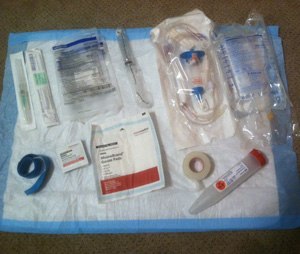Easy Way to Start Iv on Hard Stick
Forget the Hail Mary tactic of "poke and pray" by knowing and using these tips to ensure you obtain IV access each and every time
Paramedics decide what medication to give, the dose, and also the best route – oral, intranasal, inhalation, sublingual, intraosseous, transdermal or injection – of administration. Though all routes have their place, intravenous ("within vein") therapy is fast and has 100% bioavailability, meaning the drug is unchanged by absorption or metabolism when it reaches systemic circulation.
When you face a difficult IV start, forget the Hail Mary tactic of "poke and pray" and use one or more of these 10 tips to ensure you get the line each and every time.
1. Challenge yourself when you're learning

When you do your clinical rotations and practice starting IVs, you have the benefit of learning in a controlled environment with a support team of nurses and doctors. Since you're still learning, the natural tendency is to go for the easiest veins, often found in the antecubital fossa (AC) pit area of the elbow. Instead, challenge yourself by starting IVs on the top of the patient's hand or along the forearm. Then, when you're in the field treating a critical patient who presents with limited IV site options, you'll be an expert at hitting many locations.
2. The patient is your best resource
Most everyone has had their blood drawn or had an IV at some point and nobody knows their body better than the patient. Before you start, say something like, "What vein is best for you?" and you'll be surprised at all the helpful information you receive. The patient will often steer you to their best vein, warn if they're a hard stick and usually add some important information about their medical history, such as past surgeries.3. Use your office or create a workbench
"Starting an IV is one of the most dangerous things we do," my paramedic preceptor told me during internship. Given the rough neighborhood in which we worked, I initially scoffed at this idea. But then I thought of all the bloodborne pathogens, such as HIV and hepatitis B that can be transmitted with a needlestick and realized he was right.
Unless your patient requires an immediate intravenous medication, such as dextrose for low blood sugar, try to start all your IVs in your clean, spacious, well-lit office … the back of the ambulance. If you have to start an IV on-scene, create a "workbench" by spreading out all your IV supplies on a blue chux pad. Your equipment will be easier to use, easier to clean up, and the chux pad alerts everyone on scene where the IV supplies are, ensuring that a needle doesn't end up in the bench seat, on the floor or in the folds of the patient's clothes.
4. Prepare your patient
To reduce their anxiety, let your patient know what you're doing and why. Keep the ambulance warm to prevent their veins from constricting. Once you tie the tourniquet, hang the patient's arm as low as possible to allow the veins to fill with blood. Lay all patients flat who are exhibiting signs of shock.

Learn more
How to lessen a fearful patient's discomfort
While starting an IV or giving someone an IM injection doesn't hurt you – the provider – a bit, that doesn't mean it's the most pleasant experience for the recipient
5. Enlist the help of your partner
Sure, we can all start IVs by ourselves, but the process is so much smoother for us and our patient when we ask our partner to assist with tasks like holding the limp arm of an unconscious patient, attaching a drip set to an IV bag of normal saline or preparing the saline lock and IV site dressing. By delegating these small tasks, you can focus all your attention on getting the vein and staying connected with your patient.
If you miss the IV multiple times, let your partner start the IV. Sometimes another set of eyes and hands is all that's needed. You should never let pride get in the way of good patient care.
6. Choose the right size catheter
The patient's medical history and chief complaint should determine the catheter size you choose. Smaller gauge catheters (20-22g) can be used on non-emergent calls or on patients who might have blood vessel disorders such as IV drug addicts, chronic steroid users, elderly patients with fragile veins or those with a history of chemotherapy. Use larger gauge needles (14g, 16g, 18g) on patients who may need surgery or emergency medications. On these patients, consider starting two IVs and using a pressure bag to assist with fluid replacement.
7. Choose the right vein
Feel for the best vein instead of using your eyes. The veins your eyes fix on immediately are, oftentimes, superficial, thin and too fragile for an IV. Instead, find the patient's deeper veins by palpating with your forefinger, searching for the ones that are engorged with blood and have that "bounce."

Learn more
4 steps to owning the infant IV
From where to begin, to last-resort options: Tips and tricks I've picked up during hundreds of pediatric IV placements
8. Master the art of inserting a catheter
Scrub your IV site vigorously with an alcohol prep pad which will both clean the site and help the veins pop up. Place your tourniquet 2-3 inches above your desired site. Pull traction on the skin below the site with your non-dominant hand so the vein doesn't roll. Pierce the skin, then advance the catheter until you get a flashback of blood in the chamber. Then, flatten out, and advance the catheter off the needle and into the vein. Tamponade above the insertion site, then retract the needle and place it into the sharps container. Finally, attach your saline lock, release the tourniquet and celebrate your success.
9. Secure your IV site
Much like placing an advanced airway, we work hard to start an IV. Honor your efforts – and the patient's experience of an invasive procedure – by securing the IV with a site dressing or tape so it won't get inadvertently pulled out during transport or when you're transferring your patient to the hospital bed. For some patients, like kids or patients with altered mental status, immobilizing the extremity with a sling and swathe or comfortable splint can help protect the IV site.
Also, like an endotracheal tube, your IV may remain in place with the patient for many hours or days at the hospital so always use sterile techniques that provide the best continuity of care.
10. Enjoy the challenge
EMS is a difficult job. Enjoy the challenge of working in an office that is speeding over bumpy roads and around corners with a small staff.
Above all, have faith in your abilities. Few people can do the job you do. Confidence breeds IV competence!
Share your IV success tips in the comments.
This article was originally posted Sept. 18, 2015. It has been updated.
About the author
Kevin Grange works as a paramedic with Jackson Hole Fire/EMS and is the author of the new memoir about paramedic school, titled "Lights and Sirens: The Education of a Paramedic."
Source: https://www.ems1.com/ems-products/medical-equipment/vascular-access/articles/10-intravenous-access-tips-for-medics-and-students-KjACpvWLoWBqMyvv/
0 Response to "Easy Way to Start Iv on Hard Stick"
ارسال یک نظر